OKC mitigating damage of 88,000-gallon oil spill, one of the state's worst since 2010
Frontend loaders, backhoes and tractor-trailers carrying tanks and vacuum equipment buzzed across dusty ground next to a housing addition and a busy highway in northwest Oklahoma City on Wednesday as workers attacked potential environmental issues posed by an 88,000 gallon crude oil spill that occurred Monday.
The work being done by Energy Transfer, operator of the line near NW 184 and Portland Avenue, and contractors it hired were expected to remain on site for at least the next several days, officials said Wednesday.
Tasks involved in the cleanup include recovering small lakes of spilled crude, removing or remediating contaminated dirt and flushing city-owned storm drains with fresh water to prevent any polluted water from flowing into a pond or nearby Bluff Creek.
The drain flushing isn't expected to end until water captured at the end of the flows is clean, while work to remove contaminated soil at the spill location is expected to continue until what remains is oil-free.
Making sure all the oil is removed matters.
If any resulting pollution were to make it to Bluff Creek, it eventually could flow into Deer Creek and ultimately the Cimarron River. Oklahoma City's water supply in Lake Hefner, which is upstream from the spill site, was never in any danger, the city's environmental superintendent told The Oklahoman.
The cleanup work is being overseen by the Oklahoma Corporation Commission's oil and gas division and Oklahoma City's storm water quality division. No lasting environmental impacts on the surrounding area are expected, representatives of both agencies said this week.
The breach happened about 10:30 a.m. Monday as a road builder cleared ground at the site, creating a geyser of oil that could be seen by passing motorists until Energy Transfer was able to shut it down.
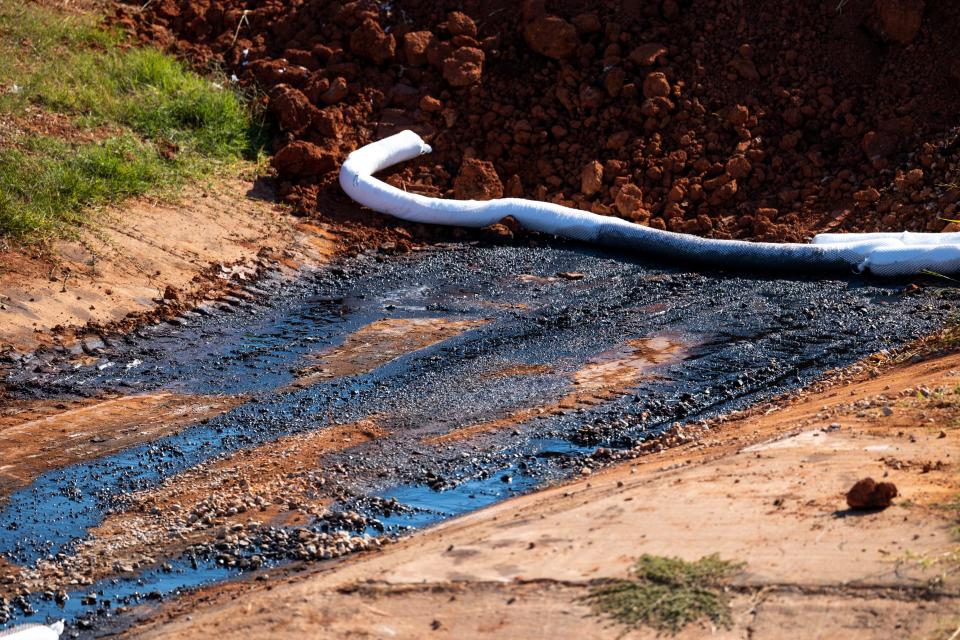
The 16-inch line that was hit is one of two that carry crude oil between Cushing and Midland, Texas. When operational, the lines have a capacity of thousands of barrels per day. A barrel of oil contains 42 gallons.
Known as the “pipeline crossroads of the world,” Cushing has more than 430 oil storage tanks spread out along the southern and northern edges of town. Cushing, which sits about 70 miles northeast of Oklahoma City, was once home to 53 refineries, but the last one was closed by Kerr-McGee in 1987.
However, a Texas company is set to build a $5.6 billion “next generation” refinery in Cushing that will be one the country’s largest, processing 250,000 barrels of light crude daily.
Where does this spill rank among other spills in Oklahoma?
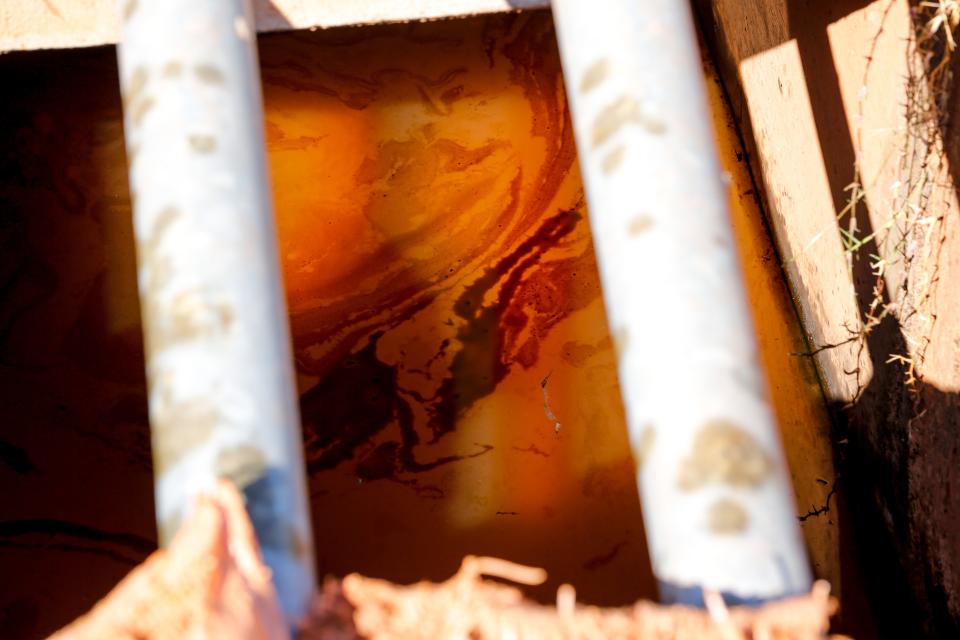
Oklahoma's regulators routinely deal with hydrocarbon spills. Monday's event was not the biggest they've seen, according to Matt Skinner, the Oklahoma Corporation Commission's public information manager.
In March of 2018, a broken Centurion Pipeline pipe leaked 139,776 gallons of oil into a pond near the intersection of County Line and Memorial roads. The spill killed fish and wildlife. It took more than a month to remediate the pond and surrounding area.
In July of 2022, two ponds in a park inside the town of Cyril were contaminated by 248,220 gallons of oil-based drilling mud that had been stored inside of tanks the operator, Stellar Drilling Fluid, believes were deliberately opened by a saboteur (a security fence around the tanks also had been cut). Remediation efforts lasted for nearly half a year after that event.
Another May 15 this year involved a storage tank in Cushing owned by Plains Pipeline that sprung a leak and released 187,194 gallons of oil into a diked ponding area built around the tank for safety purposes. The oil did not make it beyond the dike, and no wildlife or fish were affected. It took about a month to remediate the area.
A spill in August near Kremlin released an estimated 168,000 gallons of oil onto surrounding farmland after heavy rains breached a dike surrounding a drilling mud treatment and disposal facility. Cleanup there continues this week.
Pipeline Safety Trust, an organization that promotes pipeline safety through education and advocacy, routinely monitors pipeline breaks happening across the nation.
It ranks Monday's Oklahoma City spill the eighth-largest inside the state since 2010 using the most recent data available from the U.S. Transportation Department's Pipeline and Hazardous Materials Safety Administration.
"Curiously, half the spills at this size or larger in Oklahoma have been due to excavation damage," said Kenneth Clarkson, the organization's communications director.
The other four were due to material failures, internal corrosion or an unknown cause, he said.
Spills pose threats to wildlife and people
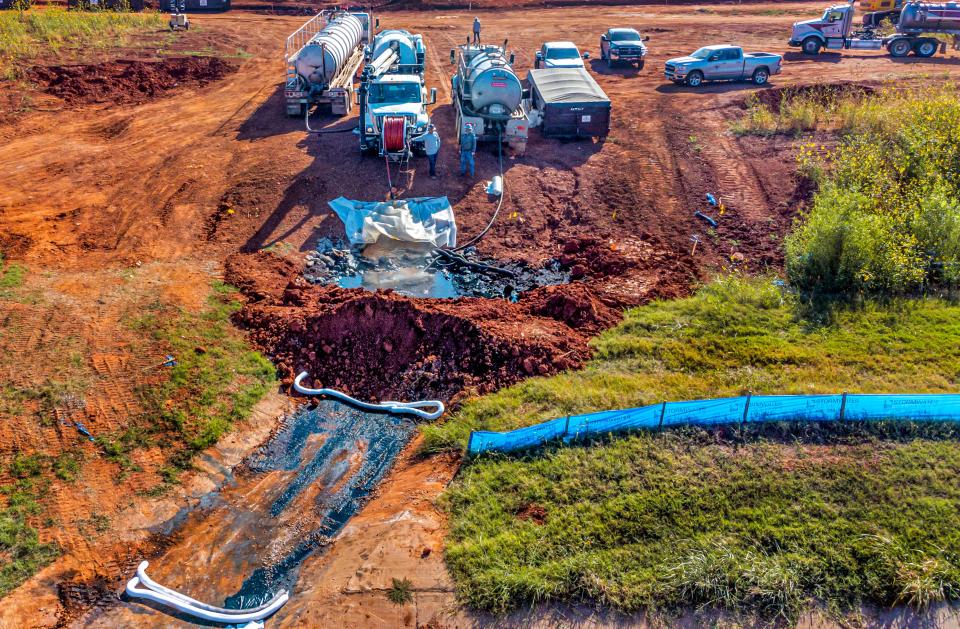
Hydrocarbon spills are never a good thing for life forms, whether they are human, microscopic or in between, said Dr. Kyle Abbott, medical director with Wild Care Oklahoma.
"These kinds of disasters have pretty far-reaching effects, and it all depends on the amount of contamination and how far it reaches into local ecosystems."
Animals exposed to oil, either by being coated with it or ingesting contaminated food can die quickly or suffer various types of longer-term reproductive or other physiological problems.
"We are still learning a lot about long-term, detrimental effects on wildlife with a lot of these oil spills that have happened," Abbott said.
"We know if it is contained, you can minimize those damages. If not, you can have pretty severe both immediate and long-term effects."
Oil on the ground is a concern, especially to organisms in water because it prevents them from getting oxygen they need to survive.
Even if quick responses prevent it from making it to nearby streams, ponds and lakes, contaminated soils also are a concern, said Amy Brittain, the risk management and ground water manager in Oklahoma Department of Environmental Quality's land protection division.
If not promptly removed, oil can work its way down through air pockets in the soil and, when exposed to rain, can leach contaminants into groundwater tables that often are sources of water for homeowners.
"If you leave it in the soil long-term, it can be a constant source of pollution," Brittain said.
Oklahoma City: Every situation unique
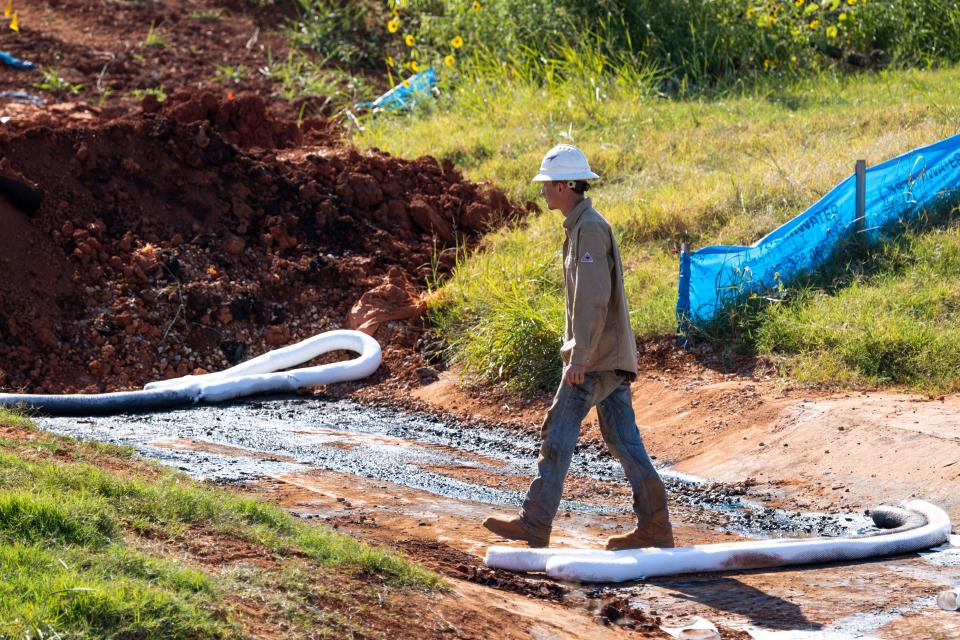
Each hazardous materials spill presents a unique set of issues that must be addressed, said Derek Johnson, Oklahoma City's environmental protection superintendent.
In Monday's case, firefighters, hazardous materials specialists and other first-responders were able to keep oil that went down nearby storm drains after Monday's line breach from reaching a tributary that feeds into Bluff Creek.
"The fire department was able to erect a final dam 355 feet west of State Highway 74, so it didn't travel very far off site," Johnson said.
On Wednesday, those drains and waterways were being flushed with fresh water to clean any residual contamination out of the system.
He expected they would repeat that process several times during coming days to ensure any remaining oil was removed.
Johnson, a 22-year city employee who has led its Storm Water Quality Division for three years, said this week's mishap is not the most significant threat his team has faced.
In some cases, past oil spills have not been discovered for days or longer, contaminating much larger areas that required more complex cleanup efforts.
On Monday, first responders were able to use onsite equipment to quickly gain control of the situation.
"The spill in this event was contained to a very limited area. It was managed very well, from start to finish," Johnson said. "The pipeline company has been extremely responsive and is working quickly to address the issue."
Investigation into incident cause continued Wednesday
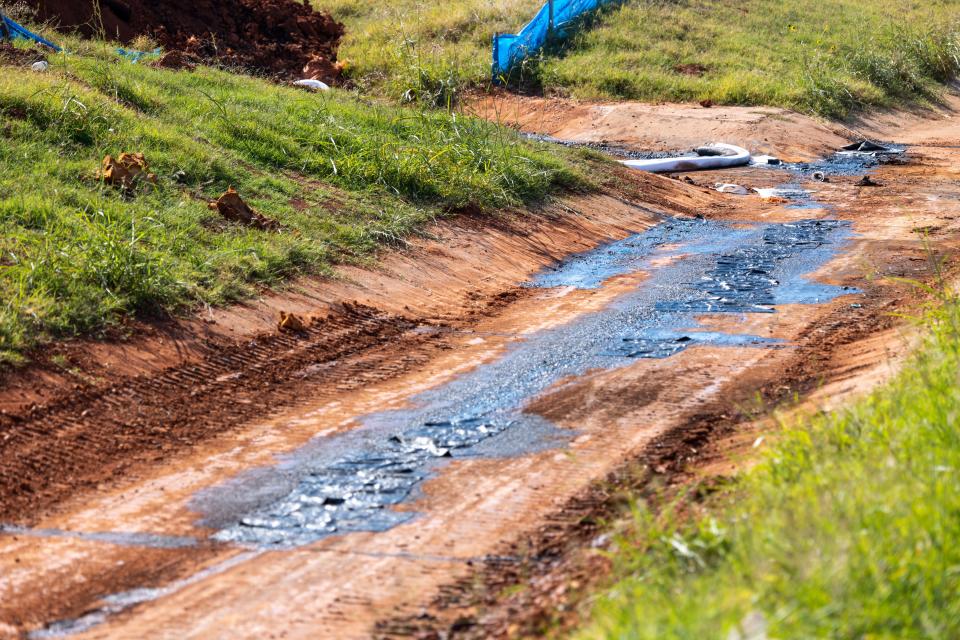
The Oklahoma Corporation Commission's Pipeline Safety Department was investigating how the pipeline break happened as cleanup work continued, Skinner said.
Under the commission's rules, Energy Transfer is responsible for making sure the area is appropriately restored because it owned the product that was spilled.
If it is determined the road contractor erred and struck a line that properly was marked, Energy Transfer could seek compensation from the company to pay the cleanup's costs.
However, that would happen outside the agency's purview, either through an agreement made between the two parties or through the filing of a lawsuit in Oklahoma County District Court.
The investigation includes record checks to ensure requests were filed and fulfilled to mark the lines. It also involves interviews with on-scene witnesses who saw how the break happened.
"Seeing an incident like this where a marked line, particularly one as large as this one, is hit is extremely rare in Oklahoma," Skinner said. "But we haven't finished our investigation.
"It is still ongoing."
This article originally appeared on Oklahoman: State agencies continue to clear 88,000-gallon oil spill in OKC

